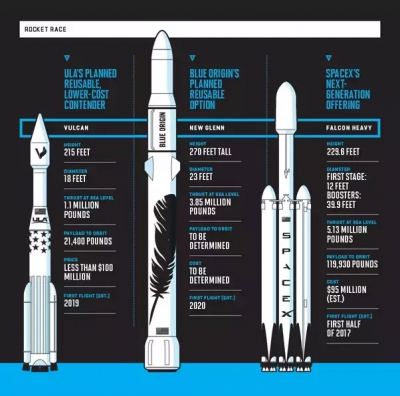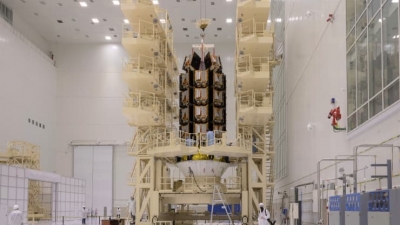Miguel Dajer, Senior Vice President Wireless Research, Futurewei Technologies, USA
Published: 29 Jul 2021

CTN Issue: July 2021
A note from the editor:
As this month saw two billionaires beat each other into space barely two weeks apart, and a third comes hard on the heel (you all know whom I am speaking of), it is only fitting to ruminate on the recent explosion of outer-space activities, where we see many traditional companies investing heavily and betting that there’s gold at the end of the emptiness that surrounds our planet. Not only do grown men compete for a ride on top of rockets, but their own companies plan to deploy lots of technology around the earth to conquer communications frontiers seldom served by traditional land-based technologies. What can money buy? In this case unprecedented innovation and a degree of success not seen before in this technology space. Will the tens of thousands of satellites that might be launched over the next decade all play nice together and deliver what their companies believe they can? Someday, those shoeboxes sized nano satellites may even send us the heavenly spectacles they see up there. Only time will tell, but the ride promises to be exciting. As always, your feedback is most welcome.
Xiao Feng Qi, PhD., CTN Associate Editor
Are We Running Out of Space, in Space?

It has been an amazing couple of years for space activities with all the new up-stars developing space related solutions, not to mention all the space cowboys that we have seen in action, from Richard Branson’s Virgin Galactic flight, to Bezos and Co Origin flight and of course, we all await Musk to ride on top of his spaceX rockets, which would complete the triumvirate of the first official consumer space “tourism”. Last week, and for the first time in decades, we were able to hear a space launch in a commercial TV station like CNBC, I happened to be driving to work and would not change the station while it was taking place! Brought back memories of the Apollo missions and its televised launches. It is important to give credit to these companies for not just re-capturing the imagination of what is possible, but for developing tremendous technologies at cost points not seen before, so far with great reliability and flexibility.

These innovations in Space launch technology allows for the development of Space in a manner that’s more economical than ever before. We already know that SpaceX has been delivering commercial service to governments including the US, sending satellites into Space and crews into the International Space Station. We also know that these companies are in the middle of creating constellations of LEO satellites to deliver internet services to everyone on earth, will these services succeed when others failed in the past? Let us look at them in some detail.
Who Are the Players in Space-based LEO Internet Service?
We all have heard of SpaceX’s Starlink and Amazon’s Kuiper plans for LEO based internet service. But besides these two companies, we also have others like OneWeb and Telesat’s Lightspeed to name a few. The startup space for “Space” related companies is hot with a myriad of companies looking to supply solutions to make Space-based communications efficient and reliable. Another area that’s gathering some momentum is LEO nano-satellites[1] where companies have plans or have launched “nano” size LEO satellites to support IoT type solutions, companies like Sateliot and Hiber play in this area.
As we all might know, LEO satellites, unlike GEO[2] satellites, operate at a lower altitude increasing their communications capabilities as they will be able to deliver higher bandwidth at much lower delays, but at the price of having to deploy many more satellites in order to cover the desired geography. In looking at the numbers, Starlink has launched over 1700 satellites to date, and their plans call for deployment of up to 42,000 total units; Project Kuiper’s constellation will consist of 3,236 satellites, in April of this year they contracted ULA to launch its first nine satellites and Amazon is obligated to launch at least half of the total by 2026 to retain the operating license the FCC has granted the company; Telesat Lightspeed has plans to launch close to 300 LEO satellites with plans to serve several markets, including backhaul services for mobile network operators and internet service providers, aeronautical and maritime connectivity, and government customers; last but not least on our list is OneWeb, with the company planning to launch 648 satellites by 2022, so far they have launched approximately 140. Like Lightspeed, OneWeb plans to focus on B2B services, rather than consumer. According to their CEO Neil Masterson, “OneWeb’s proposition is very simple, we provide fiber where there is no fiber, whether that’s cellular backhaul, acting as an emergency backup, or building WiFi networks for remote factories and manufacturing”.

We can say that the two largest players in this business are Starlink and Kuiper, they are also vastly different in their business objectives. On the surface, just like OneWeb and Telesat, they both plan to offer internet access or connectivity of some sort, with Kuiper having great differentiation potential given the vast resources that Amazon possesses. “If they succeed in vertically integrating Kuiper with AWS for instance, they will be able to offer end to end cloud-based services anywhere Kuiper is available, this includes resources for cloud computing, machine learning, data analytics, and more” said Zac Manchester, an assistant professor of aeronautics and astronautics at Stanford University, and we fully agree, although this promise is far from realization. How does Starlink respond? The company has closed a deal with Microsoft to provide connectivity anywhere on the planet.
Is There Enough Space in “Space” for All of This?
With so many LEO satellites planned to be launched there are worries about the negative effects that it could have in many areas including, as an example, earth-based astronomy. But given that our focus is on communications, we will worry about issues like potential interference between all of these satellites, an issue to which countries have started to take notice. Recently Ofcom indicated that the complexity of these large satellite networks has raised interference concerns. To that end, Ofcom has proposed new rules in a report that details its interference concerns. Ofcom indicated that “it intends to amend satellite licenses already issued to SpaceX and OneWeb to require coordination of frequency use”. “Without new requirements, the risk of interference could prevent competition by shutting new players out of the market”. "Since Non-Geo-Stationary (NGSO) satellites are moving relative to each other and relative to the ground, in-line events may individually only be brief, maybe a few seconds. However, if an in-line event occurs and causes interference, it may take longer for the terminal to reconnect to the network. The interference could continue to repeat over time, reoccurring in a regular pattern which will depend on the orbits of the respective systems."
And UK is not the only country with these concerns, in the US there’s already discussion in the FCC to provide further rules on how to coordinate the operation of all these constellations. The involvement of regulators is actually a good thing as it shows interest in the technology, while adding clear rules will result in systems that will operate more reliably, to the benefit of all of its future users.
Enter 3GPP
At the end of R14 3GPP had concluded that cellular connectivity was not limited to traditional terrestrial systems and issued the statement in figure 3. Since then, discussion about NTN or Non-Terrestrial Networks[3] as part of an integrated communications eco-system has increased substantially.

According to 3GPP, “These Non-Terrestrial networks feature in TSG RAN’s TR38.811 Study on NR to support Non-terrestrial Networks” would:
- Help foster the 5G service roll out in un-served or underserved areas to upgrade the performance of terrestrial networks
- Reinforce service reliability by providing service continuity for user equipment or for moving platforms (e.g., passenger vehicles-aircraft, ships, high speed trains, buses)
- Increase service availability everywhere; especially for critical communications, future railway/maritime/aeronautical communications
- Enable 5G network scalability through the provision of efficient multicast/broadcast resources for data delivery towards the network edges or even directly to the user equipment”
Work on R17 and 18 of 3GPP has specific Work-Items related to NTN, and although this work is currently limited in scope, it is clear that NTNs are here to stay as part of the communications ecosystem. We hope and expect that 3GPP can expand the scope of its work to fully integrate these networks in the overall wireless network solution space. We also hope that companies like OneWeb, Amazon and Starlink can actively join forums like 3GPP in order to provide the type of diversity of thinking needed to achieve this grand vision.
In Closing
With 5G bringing so many new possibilities for new types of communications, we also need a flexible infrastructure that can serve the needs of everyone and everything from the north pole to the south pole. With the adoption of NTN work in 3GPP these new networks are being validated and recognized.
I for sure appreciate the massive investments that these private enterprises are making to advance communications beyond traditional borders, reaching places that until today have been underserved or overlooked. Delivering ubiquitous, high quality internet capabilities to people and businesses anywhere has always been a dream that seems much closer if these companies succeed in their objectives. Many challenges remain for sure, and much investment is needed, but we have also seen how these businesses have been able to cross barriers that seem impossible just a few years ago, let us continue to root for their success and support the technology development needed to make them a reality.
Footnotes
[1] The term "nanosatellite" or "nanosat" is applied to an artificial satellite with a net mass between 1 and 10 kg (2.2 and 22.0 lb). Designs and proposed designs of these types may be launched individually, or they may have multiple nanosatellites working together or in formation, in which case, sometimes the term "satellite swarm" or "fractionated spacecraft" may be applied. Some designs require a larger "mother" satellite for communication with ground controllers or for launching and docking with nanosatellites. Over 1300 nanosatellites have been launched as of January 2021. (Reference: https://en.wikipedia.org/wiki/Small_satellite)
[2] Satellites are designed to orbit Earth in one of three basic orbits defined by their distance from the planet: low Earth orbit, medium Earth orbit or high Earth orbit. The higher a satellite is above Earth (or any other world for that matter), the slower it moves. This is because of the effect of Earth's gravity; it pulls more strongly at satellites that are closer to its center than satellites that are farther away.
So a satellite at low Earth orbit — such as the International Space Station, at roughly 250 miles (400 km) — will move over the surface, seeing different regions at different times of day. Those at medium Earth orbit (between about 2,000 and 35,780 km, or 1,242 and 22,232 miles) move more slowly, allowing for more detailed studies of a region. At geosynchronous orbit, however, the orbital period of the satellite matches that of the Earth (roughly 24 hours), and the satellite appears virtually still over one spot; it stays at the same longitude, but its orbit may be tilted, or inclined, a few degrees north or south. (Reference: https://www.space.com/29222-geosynchronous-orbit.html)
[3] Beyond satellites, non-terrestrial networks (NTN) refer to networks, or segments of networks, using an airborne or spaceborne vehicle for transmission. Airborne vehicles refer to High Altitude Platforms (HAPs) encompassing Unmanned Aircraft Systems (UAS) - including tethered UAS, Lighter than Air UAS and Heavier than Air UAS - all operating at altitude; typically, between 8 and 50 km, quasi-stationary. Source: 3GPP
Statements and opinions given in a work published by the IEEE or the IEEE Communications Society are the expressions of the author(s). Responsibility for the content of published articles rests upon the authors(s), not IEEE nor the IEEE Communications Society.
Comments
Nice overview of things. Two things come to mind: 1) satellite connectivity is not just for underserved or overlooked places. Having more choices for connectivity could benefit all consumers and businesses. 2) You ask if we're running out of space in space, but you don't address the concept of the Kessler syndrome. It would be interesting to know if with all the LEO sats going up, is there a risk of them colliding into each other? What about collisions with things coming and going from space (rockets and tourists)? Or, is there actually plenty of room at 300-500km and above?
Submitted by djkrauss@gmail.com on 2 August 2021
Dear Alan, thanks for your comment. I agree, in the past there was little standardization and we all know success on space-based telephony has been limited at best. This time around I do believe it will be different as the purpose is not just to serve niche markets, but to also integrate vertically and to offer services beyond telephony across a very diverse set of markets. As I mention in the article, there's great interest to bring together LEO and terrestrial communications. 3GPP has started the work but as you state, effort is rather muted, so they will need to do more and market pressures in my opinion will make it so. Also, companies like Qualcomm and others are standing behind this broad communication spectrum, that will also be an important driver.
Submitted by migueldajer1@g… on 2 August 2021
Dear DJ, agree on the markets comments and although didn't get into details, I do mention that vertical integration is one of the objectives of some companies, this will lead to supporting services beyond traditional telephony with many of these being target to B2B and C2B type market segments. The issue of The Kessler syndrome is perhaps deserving of a separate article, we welcome volunteers. My intent was to provide a broad perspective in the hopes to have follow up on issues like this one. I do mention that regulators in several countries are starting to worry about many issues, from interference to things like terrestial astronomy. There's a lot of junk in space, and there's bound to be much more over then next 10 years.
Submitted by migueldajer1@g… on 2 August 2021
Interesting article. Interference concerns among multiple LEO constellations are important, and worthy of detailed study. I would, nonetheless, encourage COMSOC
Submitted by dmcclure1@comc… on 2 August 2021
[Previous comment was truncated] Interesting article, and the issue of interference is going to require a good deal of study and detailed cooperation among LEO operators. Separately, I encourage COMSOC to run articles through editing prior to posting to avoid use of wornout phrases ("as we all might know", "last but not least"), incorrect punctuation and incorrect sentence structure. Our verbal communications should be as good as the communication systems we design.
Submitted by dmcclure1@comc… on 2 August 2021
There is plenty of room at the top? Regarding the crowding of LEO, some fairly simple calculations reveal that if ALL the planned nanosatellites are launched (46184 by my count) at an orbit a bit higher than ISS, then the satellites occlude 1 part in 1 trillion of area (assuming nanosatellite area of ~1 ft^2). I would not want to hang out at that altitude for very long, but transiting though the orbital shell seems pretty safe (and when the orbits are KNOWN it would be safer). As for collisions, by varying the orbital altitude a bit the safety margins can be greatly increased. Of course, it should still be the case that end-of-life satellites should be lowered into the atmosphere in a controlled fashion ... that is, until someone launches a facility into LEO to recover and recycle all that valuable material. I believe the main collision danger comes from uncontrolled stuff whizzing through space; if all those nanosatellites can be maintained in controlled orbits then deorbited after use, then space can remain (fairly) safe.
OTOH, the astronomers (especially radio astronomers) have ample reason to complain. An optical and radio observatory on the far side of the moon handily (though expensively) resolves that problem though.
Submitted by garyantes@ieee.org on 2 August 2021
An interesting read that touches on the issues that will face this industry.
https://www.thebulwark.com/rival-wants-regulators-to-cripple-elon-musks-satellite-project/
Submitted by migueldajer1@g… on 4 August 2021
July's IEEE Communications magazine includes the article "LEO Satellite Constellations for 5G and Beyond: How Will They Reshape Verticals Domains?" An excellent read for those interested in NTN and its potential.
Submitted by migueldajer1@g… on 23 August 2021



Thanks Miguel, great article. Got me thinking about how little standardization there was in the LEO business, compared to cellular. Will we one day be able to buy a phone that can connect to all of these satellites, so that I can change service provider without changing out my equipment? Can LEO be successful without that? And has 3GPP come in with too little too late on this topic?
Submitted by gatherer@ieee.org on 1 August 2021